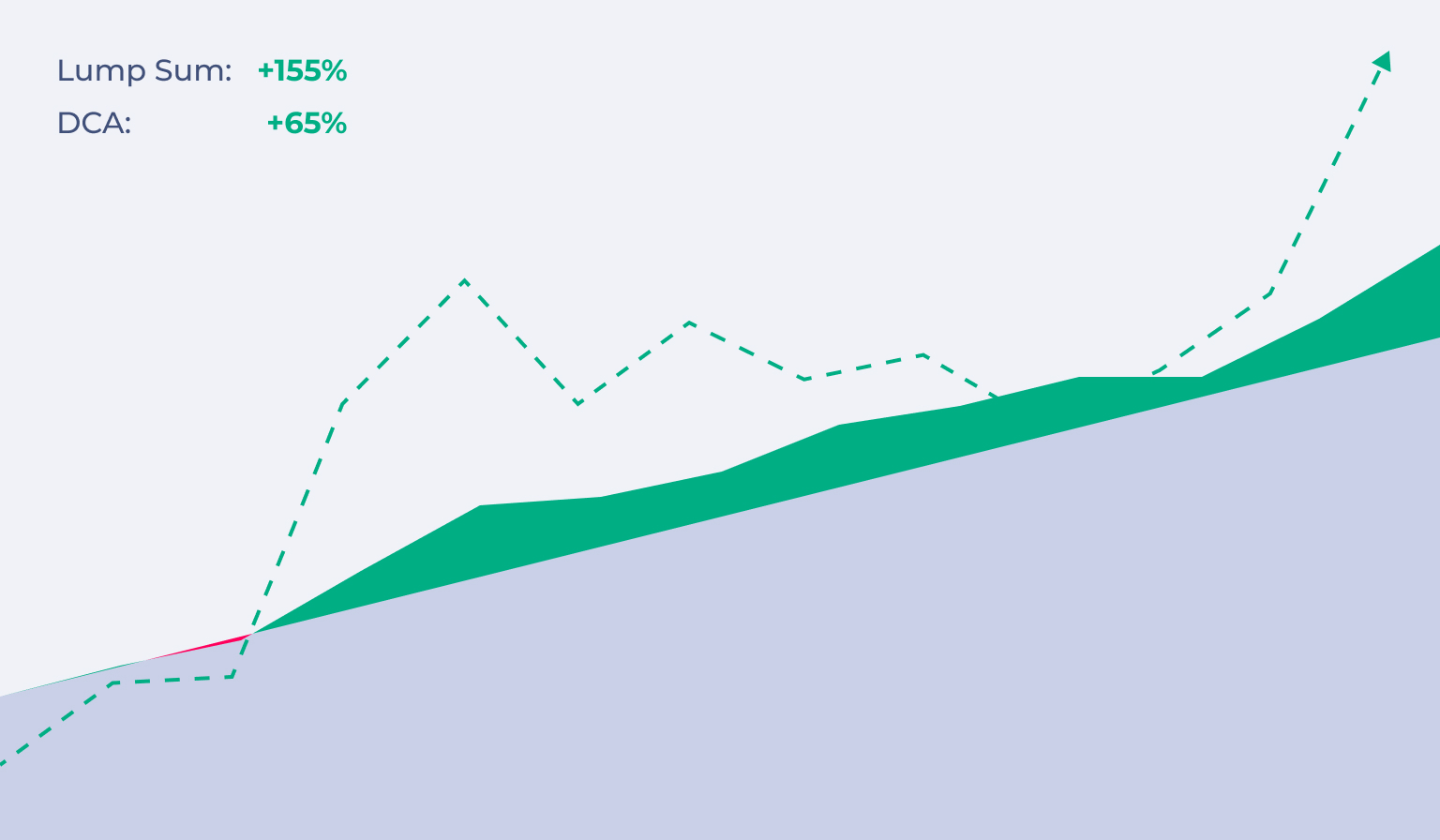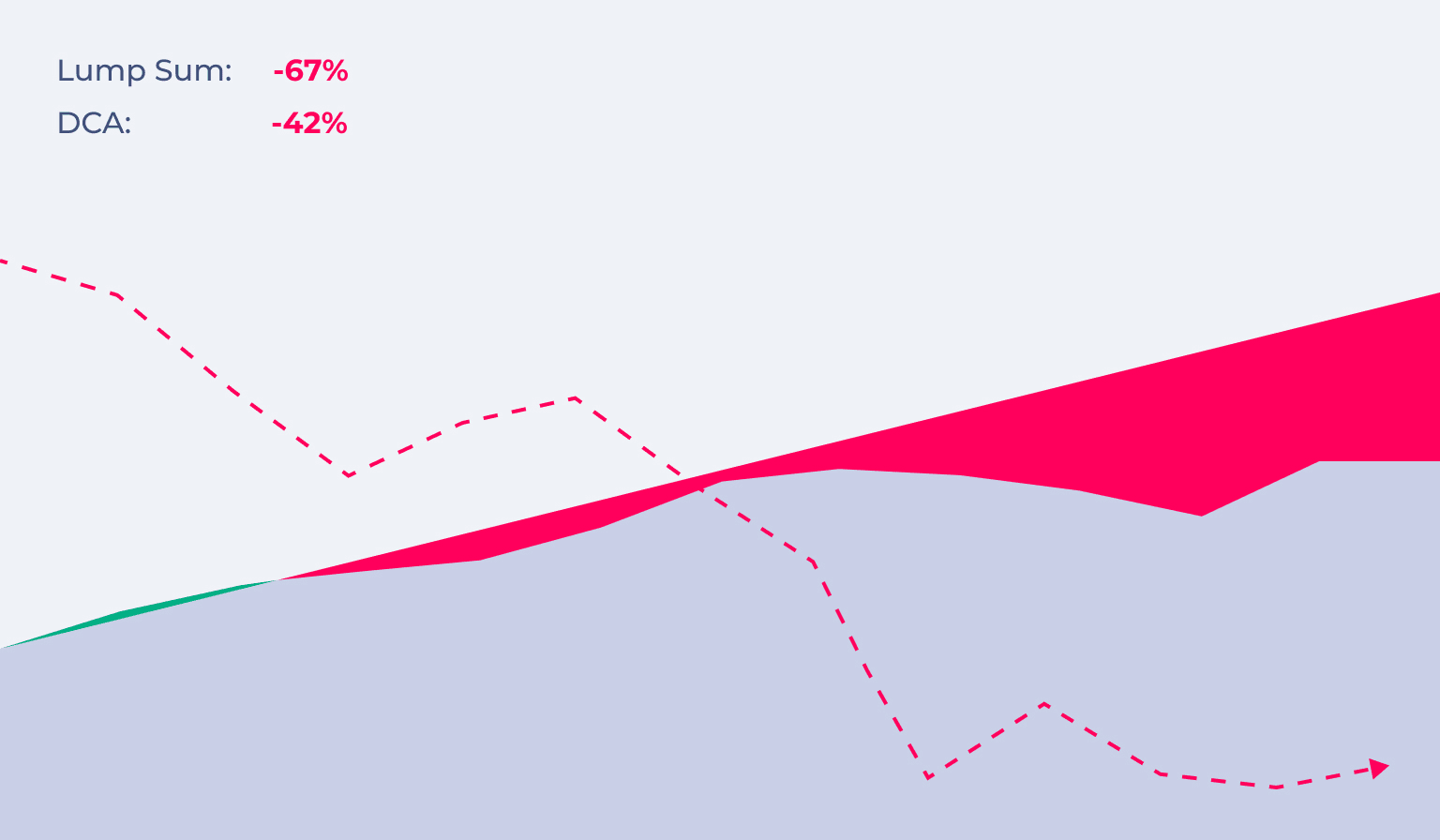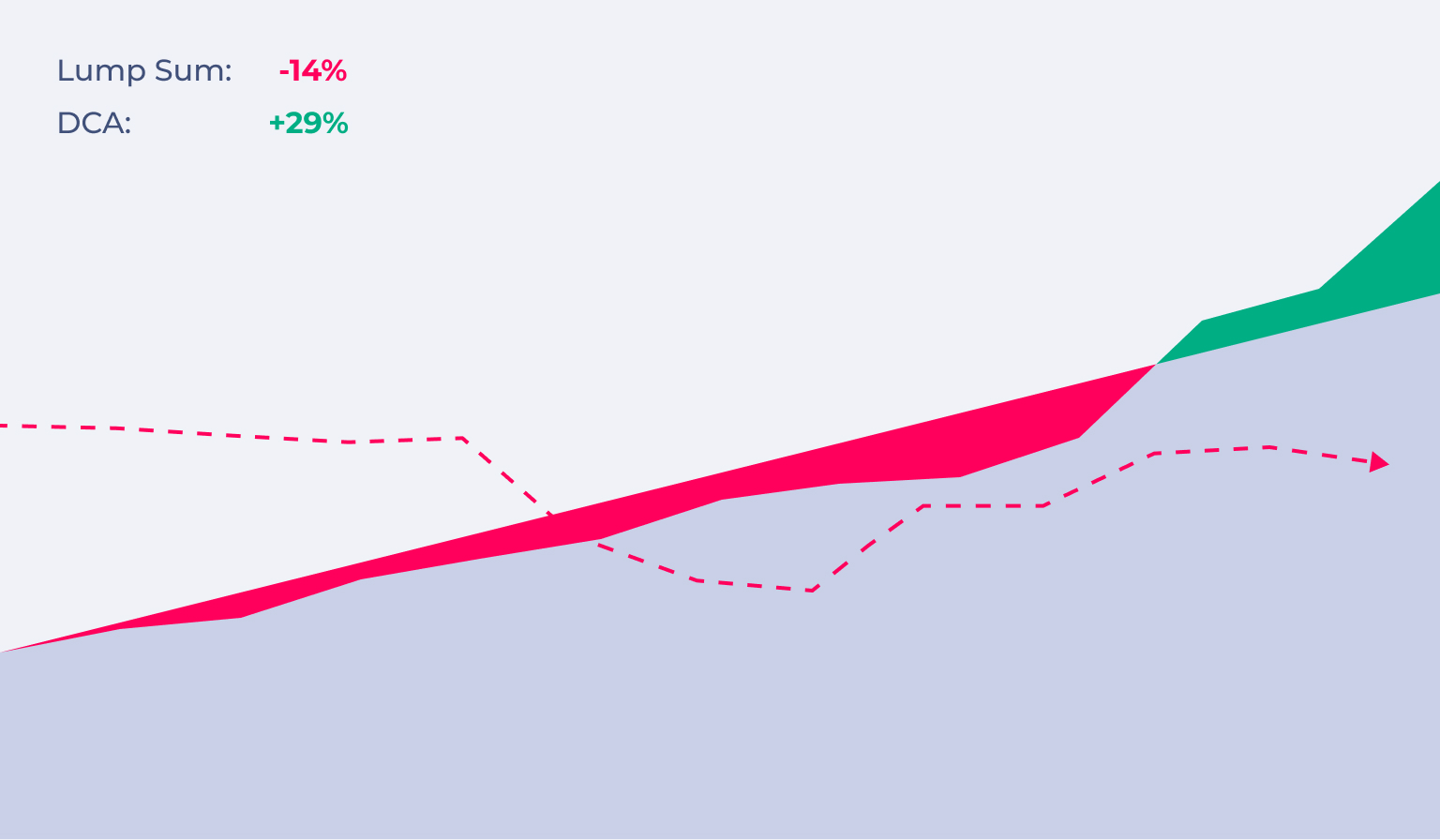DCA: Boring Makes Money
The dollar-cost averaging primer for your friend who needs it.
There is an abundance of articles about dollar-cost averaging, but what I consider essential for this strategy was never put together in a way I would be able to recommend as a first read for people who ask. While I was writing it, I realised, it’s becoming a introduction to investing in general. If you’re starting the investing journey—I wrote it especially for you, but if you’re a few steps further—I hope it will still offer some value, by addressing some less popular topics like psychological challenges and risk management.
Dollar-Cost Averaging (DCA) means investing the same amount of money in fixed time intervals without paying any attention to the price of an asset. You believe in the asset as a long-term investment, so when you buy, you ignore if the price is high or low, and stack another piece week by week, month by month.
A real life example: Buy $500 worth Vanguard ETF every first Monday of the month.
Why is DCA so good?
The simplest way to understand DCA—and I cannot emphasis it enough, take a deep breath, and prepare your brain to let it really sink,ready?—is to understand this:
You don’t know if the price today is high or low.
That’s it.
A “black swan” event can make the price drop tomorrow, and it will not recover for the next 3 years, or can make it climb overnight and never ever be that low again in your lifetime—you don’t know.
If you think you “know” what it will be in a week, month, or year from now, you’re either completely clueless and still waiting for the market to give you this essential lesson, or… you’re an investing genius that doesn’t need this article. I will still write it for everybody else.
But we need to start from the beginning:
“The Best Bank in The World”
We teach kids the importance of saving by giving them a piggy bank. This is a crucial part of financial education, but you know what is the next most important lesson that most people don’t understand enough?
There is also a way better magic piggy bank for adults that multiplies whatever you put in. It’s called the Market.
Here is the catch:
While long-term, the “piggy” is the most reliable bank in the world where the best money managers keep the majority of their funds, short-term… is a chaotic mad man randomly throwing prices up and down.
The remedy for this “madness” is DCA. While prices can swing up and down on a daily basis, averaging mitigates your risk and goes through the bumpy road like a good off-road 4x4.
You start humble investing just a bit, and while you slowly put more and more money in, the DCA:
- smoothes your average price out
- gives the market time to rise up
When the price drops, you buy the next piece so your average price is going down. The lower the average price, the easier it is to be back in profit. This approach recommended by legends like Warren Buffett is tested for multiple decades and works no matter if you invest in Coca-Cola or Bitcoin.
So, why is investing so hard?
In the long-term, the world economy is growing, so are the asset prices. On average, the most popular index in the world—S&P 500—grows 10.5% a year—effectively the market doubles your money every 7 years.
Unfortunately, the average investor earns only… 4% a year.
Surprisingly, it’s not because it’s hard to pick the right asset—just buy an S&P 500 ETF, done!—but because of investing psychology. Putting money on the market exposes us to strong emotions: opportunities trigger our primal cravings, fantasies, while price swings unleash deep fears.
That’s why despite having a good initial plan, most of the investors fail at execution. They fail trying to beat dollar-cost averaging.
Most people may think that investing is technically difficult and requires knowledge. The reality is, I can explain how to invest successfully in just a few sentences. The real obstacle that stops you from winning is in your head:
- Taking risks is exciting, trading is entertaining while DCA is kind of… boring.
- Our ego wants to feel “smart” and implement its own “better” ideas.
You can indulge yourself with reckless trading your life savings, and let your impulses drag you down, or you can realize your weakness, and take it under control.
Here is one of the essential risk managing strategies I recommend for everybody who can’t turn the urge to play on the market off:
Risk Management: Core/Satelite Portfolio
Split your investing into two portfolios:
Main Portfolio — at least 80% of your funds. Dollar-cost average into reliable macro assets: broad market ETFs, Bitcoin, gold, REITs — get some ideas here — but let’s make it clear: dollar-cost averaging is not a way to avoid losing money if you invest in a meme coin. Keep this one boring. You may not believe it yet, but “boring” makes the real money.
Satellite Portfolio — no more than 20%, possibly 5% (and don’t increase its size if you cannot grow it). Use this one for all your other investing ideas. I still don’t recommend gambling memecoins, but if this is what you need to satisfy your excitement, and keep your main portfolio on the track — let it be.
Now, since we’ve set the stage, we’re ready to enjoy…
The beautiful math of DCA
Those three charts show how DCA, compares with a simple lump sum investing in the only three market scenarios that exists:
When the market is going up, while you earn less than putting everything in, you get a smoother “ride” that increases your chance of not freaking out which is the main reason why people cannot fully benefit from those exciting moments. DCA will get you through it.

When the market is going down, you lose less than if you would by investing a lump sum. You also average your price down. So compared to the lump sum investing: you’re back in profit sooner.

When the market is going sideways — that is interesting! — with DCA you’re in profit even if the price of the asset is the same at the end. How is that possible? By taking advantage of buying at the lower prices. No timing is needed, DCA buys all the “dips” blindly.

How to DCA properly?
Let’s start by noticing that if you invest a fraction of your paycheck, you’re dollar-cost averaging by default because your investing funds drop in on a recurring schedule. So, don’t make it more complicated for no reason—when the money hits your account—invest without checking charts and looking for “the right moment.”
Remember that the “averaging” effect we discussed on the charts in the previous section works the best when you invest the same amount in the same intervals. If you try to outsmart the market by “investing more when the market is down” or try other “improvements” — it doesn’t work. There is no simple automated way to beat “vanilla” DCA.
But what if your available funds are significantly larger?
Be aware that if it’s a life-changing amount, putting it all in the hands of the chaotic mad-man we mentioned before will lower the quality of your life. You’ll experience emotions that will affect your sleep, relationships, and maybe even your work—is it really the role you want the money to play in your life?
The better way has two parts:
- Put aside enough, so your next 6-12 months of bills are covered. Without feeling safe, you’ll not be able to behave on the market rationally. Don’t set yourself to failure before you even start. Have a “rainy days fund” first.
- Then spread your investment over a year or two. Go in slowly, dollar-cost averaging month by month, and allow yourself to learn how to stay calm while your market position grows. Statistically, there is a big chance the market will grow during this time, allowing you to enjoy the first success, but if it drops… at least your average price is way lower than if you would put all-in at the beginning.
The best strategy is only as good as your ability to implement and stick to it. There is no strategy better at this job than DCA.
The only way to make it even simpler is automation. Many brokers and crypto exchanges offer recurring buy features to help you stay consistent. Here at Deltabadger, we’ve taken crypto DCA automation to the next level - but regardless of which platform you choose, automation is your friend, that helps to avoid those common pitfalls:
Don’t let those mistakes stop you
While DCA may be the easiest strategy to follow, people still manage to blow it. Here are the most common mistakes:
Checking prices too often. Who hasn’t been there? As soon as we invested the first money, we checked the price a few times a day. It will not grow if you look at it. Kid! Jokes aside, how can you stay calm if you obsess about it 24/7. Remove the investing app from your phone, and the Bitcoin price widget from your homescreen.
Skipping contributions when markets are down (which is actually the best time to buy). You were excited to buy when the price was climbing, when it’s down, you rather think about other things, right? You can realize it’s something to pay attention to, or take advantage of a DCA bot that will never skip a day.
Getting discouraged by short-term losses. Seeing red numbers is upsetting. I get it. Diversify, pick big reliable assets (not single stocks and altcoins), a portfolio that is easy to believe in, but you should always ask yourself: If in a year my investment is down 50%, how would I feel? If you know it will be a problem, just keep 50% in bonds—Voila!—your portfolio will never be down that much. Other than that, again, don’t stop investing when it’s the best time for it.
Trying to time their regular investments. It’s time to buy the next tranche, but it feels like tomorrow the price may be better? Read the beginning of this article again.
Do you see now how automation can help a lot?
The next best day to start: Today
I wrote this article as the best “DCA starter pack” I can recommend to all the friends that ask. We covered a lot, so let’s wrap up the key points:
- The market is your magic piggy bank that can multiply whatever you put in - but only if you give it enough time and stay consistent. This is exactly what DCA helps you achieve.
- Your biggest enemy isn’t market volatility or picking the wrong asset - it’s your own psychology. DCA gives you a framework to overcome these psychological barriers by making investing systematic and emotionless.
- DCA works in any market condition - up, down, or sideways. It turns market volatility from your enemy into your friend, as every price drop becomes an opportunity to lower your average price.
- An investor “welcome pack” that sets you to win:
- Start with an emergency fund to feel secure
- Keep your main portfolio simple and boring — dollar cost average
- If you need excitement, use a small satellite portfolio
- Use automation to stay consistent and avoid common mistakes
If you’re wondering when to start, remember: even $50 can set you on the right track. The amount doesn’t matter as much as building the habit, and starting building one is the best investment you can make today.
—
Disclaimer: This article is for informational purposes only and does not constitute financial advice. Investing involves risks, including the possible loss of principal. Always conduct your own research before making investment decisions.
